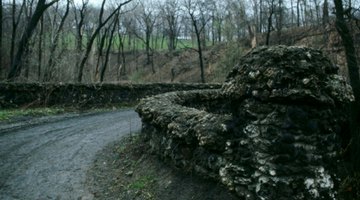How to Level a Sloped Yard
Changing the slope of your yard is labor-intensive and, depending upon the slope, may be cost-prohibitive.

You need to slope the yard away from your house to prevent water from puddling against your foundation and eventually entering the home, but you can lessen the degree of the slope and improve the functionality of the yard with a retaining wall and fill dirt.
Things You Will Need
- Stakes
- Measuring tape
- Twine
- Level
- Retaining wall blocks
- Shovel
- Dirt
- Top soil
- Rake
- Lawn roller
- Grass seed or sod strips
six inches per ten feet slope from the house
-
Set stakes every 10 feet, starting at your house and wrap those with twine. Adjust the twine so the yard slopes at least 6 inches for every ten feet of yard, sloping away from your house for proper drainage.
-
Build a retaining wall at the end of your property to the height determined by the final position of the twine. Use interlocking wall blocks so you don't have to use mortar. Set the first row of pavers in a 4-inch deep, level trench and build the pavers up from the first row. Stagger the seams for strength. Back fill behind the retaining wall with dirt.
-
Haul in dirt to fill your yard to the level determined by your twine stakes. Use fill dirt for the bulk of this job, but use quality top soil for the last 6 inches to promote healthy grass growth.
-
Rake the dirt to smooth out the surface and remove clumps from the dirt.
-
Compact the dirt with a lawn roller. Compacting the dirt now prevents uneven settling which can cause hills and valleys within the yard.
-
Seed or sod your new yard and water daily.
Tip
Check with your local government agency for permits and codes before starting this project. Talk to your local home improvement store to get estimates on retaining wall installation. Rent a lawn roller from big box home improvement stores.
The Drip Cap
- Changing the slope of your yard is labor-intensive and, depending upon the slope, may be cost-prohibitive.
- Adjust the twine so the yard slopes at least 6 inches for every ten feet of yard, sloping away from your house for proper drainage.
- Stagger the seams for strength.
- Compacting the dirt now prevents uneven settling which can cause hills and valleys within the yard.
References
Writer Bio
Angela Roe is a freelance writer who specializes in writing online articles, including topics as diverse as home improvement and decor, crafts, ballroom dancing, sports, fitness and business interests, as well as marketing and research, and business associations. She also provides SEO copy to industry-leading Web-content providers.
Photo Credits
- Jupiterimages/Photos.com/Getty Images
- Jupiterimages/Photos.com/Getty Images
More Articles



